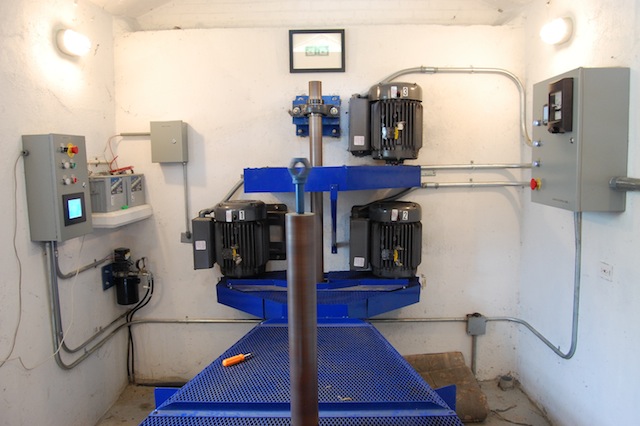The latest remote communication technologies allow experts to monitor and control multiple plants from any location.

Remote monitoring isn’t new to the industrial automation world as over 25 years ago the first remote monitoring systems were installed using dial-up phone connections. In the 1990s, these early systems advanced to hardwired Ethernet/Internet connections that offered greater speed and reliability. Today, many plants are benefiting from technologies in which wireless networks and devices are used for easier and more economical remote monitoring and control.
The advent of cellular technology has significantly expanded the ability to monitor plant operations from just about anywhere, while lowering costs and simplifying implementation. 4G technologies have made cellular connections much faster, often matching the speed of hardwired Ethernet/Internet connections.
Benefits of remote monitoring
Once only found in significant numbers in industrial applications that covered widely dispersed areas, remote monitoring is becoming a more integral part of daily operations in many manufacturing facilities, thanks to the lower costs and simpler implementation associated with the newest technologies.
Some of the factors driving remote monitoring proliferation have to do with lower upfront investment costs needed for implementation; others are the result of leaner operations and fewer operators on the plant floor. Not only does remote monitoring enable operators to monitor conditions from just about anywhere, it also facilitates more effective monitoring by fewer personnel, a real differentiator in today’s tough economic climate.
The potential benefits of remote monitoring are significant: minimizing labor costs, filling the knowledge gap resulting from experienced operators retiring, prolonging equipment life, preventing unplanned downtime, and more. However, there’s no easy answer as to what type of remote monitoring is best.
While remote monitoring can greatly contribute to cost savings and improved operations, there are considerations that must be addressed o ensure the security and practicality of implementing a remote monitoring system. Also required are definitions of what data can be accessed and by whom, and, most critically, what remote control options will be allowed.
Wireless advantages and challenges
Installing wireless networks for remote monitoring systems is becoming a common way to reduce costs associated with installing and maintaining a network. Wireless networks offer significantly more flexibility than wired remote monitoring networks that have a fixed topology. The ability to mix and match equipment from different suppliers is also much easier with wireless.
Eliminating the need to purchase and install wires and cables is the most immediate cost savings associated with implementing a wireless network. Another area for savings is the ability to add sensors much faster and for very little cost versus the high price of adding a hardwired device.
Adding sensors improves visibility into a machine’s overall functioning, or to the overall performance of a batch or continuous process. The additional data gathered from new sensors enables operators to diagnose potential problems faster and with better accuracy, which leads to improved efficiency and reduced maintenance costs.
While providing much lower installation costs, wireless networks aren’t a panacea for every situation or plant. The biggest concern with using wireless networks is security. Early wireless standards, such as wired equivalent privacy (WEP), were not as robust as they should have been, which has led to continuing concerns about data security over wireless networks.
Although security measures are vastly better today, it is still important to remember that wireless networks can be more vulnerable than their wired counterparts. However, wireless networks have become far more secure through the use of encryption, and through standards such as the IEEE.802.11X-based Extensible Authentication Protocol, which requires clients to be identified in order to gain access to the network.
But implementing and maintaining wireless network security requires certain IT knowledge, and smaller operations may not know how to implement these new security measures. Although wireless networks may pose a challenge for some users, wirelesses networking protocols and security features have advanced considerably, and wireless networks are definitely a viable option for reducing remote monitoring installation and maintenance costs.
Remote data access
Regardless of the type of remote monitoring system, great strides have been made in terms of how and where the data from these systems can be accessed. In the late 1990s, PC-based access became the norm, later followed by Web-based access.
These developments not only lowered costs, but also improved efficiency and productivity because plant operators could more easily and frequently access data. In addition to easier data access, PC-based monitoring brought about significant improvements in alarming and alarm response times. Now, many plants are taking advantage of the ability to use mobile devices such as smartphones to reduce costs and gain greater visibility into plant operations.
Whether as a result of the recession or experienced operators retiring, most manufacturing plants have fewer operators to monitor plant conditions. Process monitoring requires extensive oversight, yet plant managers can no longer afford to operate isolated diagnostics stations or assign certain operators to specific areas of the plant.
In today’s plants, many operators must simultaneously monitor multiple machines or processes in various locations throughout a facility. Without remote monitoring, potential problems may not be detected, quality can suffer, equipment can be damaged, and unscheduled downtime can occur.
More manufacturers are moving to consolidated monitoring models that cover multiple plants. With these models, highly experienced operators and engineers can access detailed, real-time information from each plant, as well as detailed historical information. Information from different plants can be compared and analyzed, often leading to early problem detection.
Remote personnel can troubleshoot issues, change an operating parameter, and shut down a machine or process to avoid possible problems. They can also advise on-site engineers and operators as to how best remedy a problem or improve performance.
This type of expertise combined with real-time visibility into daily operating conditions can extend the lifetime of machinery and process equipment. Maintenance schedules and historical data can more easily be used to determine maintenance and replacement intervals, all without having to be physically at the plant.
Cellular technology use
Smartphones have replaced individual devices that once seemed absolutely necessary. Watches, alarm clocks, cameras, maps, video recorders, calculators, recording devices, and much more now fit into a typical user’s pocket. It’s no wonder that the advances in cellular technology are being taken advantage of in manufacturing environments.
Everyday more companies are using mobile devices such as smartphones, tablets, and other handheld devices to cut costs, and to communicate information economically and quickly. While many manufacturers are enabling remote access via smartphones and other handheld devices, implementation isn’t quite as simple as checking e-mail online.
One of the main decisions that must be made is how and when to implement browser-based and app-based remote monitoring.
Web browsers: Pros and cons
The logical progression for accessing data remotely via a smartphone is to use a browser to access plant automation systems via a company’s virtual private network (VPN) as depicted in Image 1. Many companies today offer remote connectivity via a VPN, with users simply connecting to the company’s network and then interacting with the automation systems via a Web browser interface. This access is generally to a human machine interface (HMI) or a controller, although browser-based access can be used with any automation component equipped with Web-served capability.
This type of access can be very good and relatively quick when the browser is running on a PC, but can raise issues with smartphone browsers. In many cases, the Web server screens don’t scale well to the smaller displays found in handheld devices, and screens often take too long to load.
Another consideration is that often remote browser-based access provides only a snapshot of the HMI screens, which can cause problems when monitoring large amounts of data in operating conditions that change frequently.
Some Web servers and VPNs enable two-way access for remote control, but many just offer read-only access. Therefore, care must be taken when selecting a supplier or implementing a VPN solution to make sure users can perform remote actions as necessary.
While Web browser access is essentially free, the costs of designing, deploying, and maintaining the VPN and the Web servers can be considerable and must be factored in when determining overall ROI.
Using apps for monitoring and control
A different approach for using smartphones and handheld devices to monitor and control operations remotely involves the use of apps specifically designed for these devices. Extremely economical, with some costing as little as five dollars, smartphone apps can be an optimal method for accessing data. Some of these apps may offer the ability to view and control operations as if the user were in the control room in front of the HMI screen. However, as with the VPN/Web browser combination, care must be taken.
To create fully functioning remote monitoring apps for smartphones, developers must increase hardware, software, and protocol performance levels to reduce the latencies that can occur over remote connections. If not, users can become frustrated by slow or poor performance. To optimize performance, developers must also reduce the amount of data transfer from the automation components, typically HMIs and controllers.
When done correctly, using an app to access data via a smartphone can be very cost-effective and reliable. Joel Froese, owner/operator of the Red Bank Hydro Plant in Columbia, S.C., uses his smartphone for remote access as depicted in Image 2. “I can access data anytime and anywhere to ensure I have optimal operating conditions. I can start or stop the plant just as if I were standing in front of the HMI. The screens are scaled correctly, safety features are included, and I can quickly access the data I need.”
Not only is app access often superior in terms of performance, but it’s also easier to load. Browser access via a smartphone requires a user to load up the browser, then enter the address and wait for a screen to load. By contrast, app access is much quicker and requires fewer steps. Finally, app access typically requires much less IT support than VPN/Web browser remote access.
Security issues
Just as with implementing a wireless remote monitoring system, new security measures must be implemented when accessing sensitive data via a smartphone or handheld device. Regardless of whether a Web browser or smartphone app is used, remote access must be protected from unauthorized personnel, and access levels must be controlled.
Methods and technologies exist to make remote wireless connections more secure. These security measures are similar to those used for other wireless communications: encryption, password authorization, and device identification.
The required security settings and procedures can be too time-consuming or difficult for some plant managers and control engineers. To alleviate this situation, neophyte users should select a company that provides a high level of service, and has a deep understanding of both the security requirements and the technologies needed to make access via handheld devices feasible and smart.
Not every manufacturing plant will employ the same remote monitoring systems, as each system has its own pros and cons, and as each plant has different needs. But regardless of the type of access used, remote monitoring will become more the norm as technologies advance and as the need to accomplish more with fewer resources continues.
Greg Philbrook is HMI/Communications product manager for AutomationDirect.
AutomationDirect is a CSIA member as of 2/26/2015
Some advantages, disadvantages, of wireless networks
Advantages:
- Flexibility for different hardware and software types
- No cables or wiring
- Faster and easier installation
- Can provide greater visibility into operations
Challenges:
- Not a closed system as with wired networks
- Early security standards not robust
- Implementation of new security technologies can be challenging
Remote Monitoring via Smartphones
Web browser/VPN for remote monitoring:
- May provide snapshot, not real-time data
- May be read-only
- Often not designed for small displays
- Security challenges
Smartphone App for Remote Monitoring:
- Very low cost
- Wide range of functionality
- Fast loading of app
- High-speed access
- Seamless upgrades from the supplier
- Designed for small displays
- Security challenges



